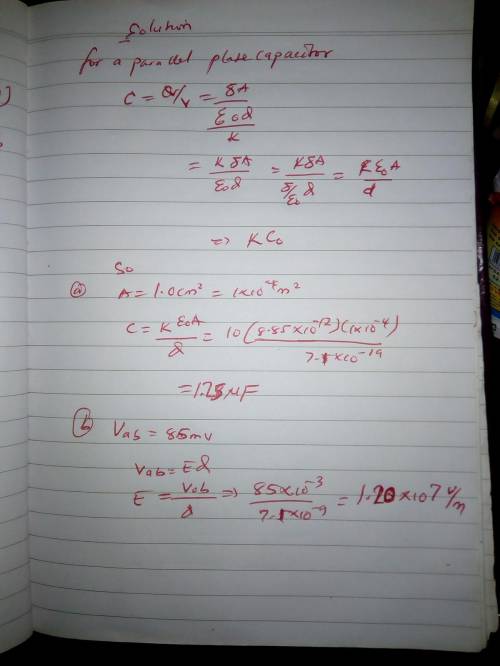
Physics, 21.07.2020 16:01 mooreadrian41235
Cell membranes (the walled enclosure around a cell) are typically about d = 7.1 nm thick. They are partially permeable to allow charged material to pass in and out, as needed. Equal but opposite charge densities build up on the inside and outside faces of such a membrane, and these charges prevent additional charges from passing through the cell wall. We can model a cell membrane as a parallel-plate capacitor, with the membrane itself containing proteins embedded in an organic material to give the membrane a dielectric constant of about 12.
Required:
a. What is the capacitance per square centimeter of such a cell wall?
b. In its normal resting state, a cell has a potential difference of 85mV across its membrane. What is the electric field inside this membrane?

Answers: 2


Another question on Physics

Physics, 22.06.2019 16:40
Panel bc in fig. p2.76 is semi-circular, with the 3 meter radius and horizontal straight edge through point b. compute (a) the hydrostatic force of the water on the panel, (b) its center of pressure, and (c) the moment of this force about point b. assume atmospheric pressure on the dry side of the panel
Answers: 3


Physics, 23.06.2019 00:00
Which one of the following represents the reduced forms of the two major electron carriers? nadh and fadh2 nad+ and fadh2 nad+ and fad nadh and fad
Answers: 3

Physics, 23.06.2019 03:30
Which statement is true? a) the work done to lift an object 6 meters is greater than the gravitational potential energy it gains. b) the work required to push an object is less than the work required to pull an object the same distance. c) the work required to raise an object to a height is equal to the gravitational potential energy the object gains. d) the work done against gravity to lift an object straight up is greater than the work required to roll it up a ramp.
Answers: 1
You know the right answer?
Cell membranes (the walled enclosure around a cell) are typically about d = 7.1 nm thick. They are p...
Questions


History, 29.06.2019 01:30






Mathematics, 29.06.2019 01:30

Mathematics, 29.06.2019 01:30






Mathematics, 29.06.2019 01:30


Mathematics, 29.06.2019 01:30

Mathematics, 29.06.2019 01:30


Mathematics, 29.06.2019 01:30




